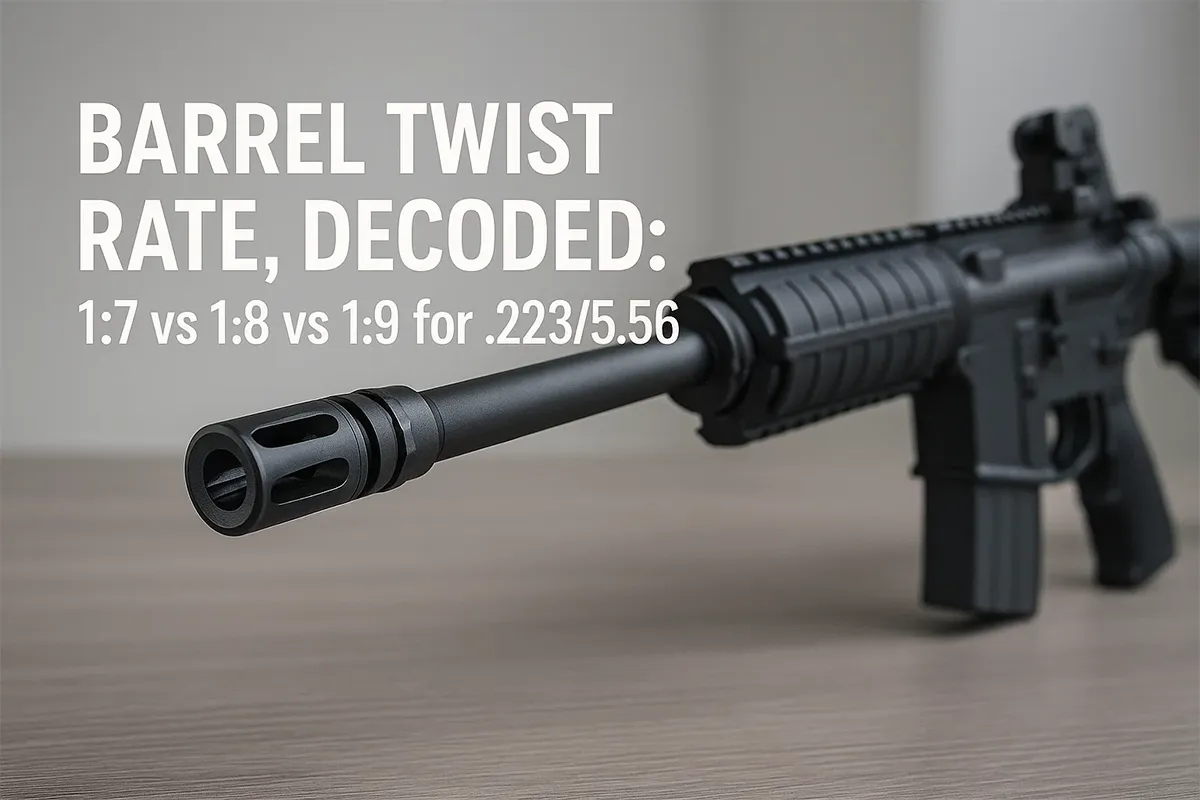Barrel Twist Rate, Decoded: 1:7 vs 1:8 vs 1:9 for .223/5.56
October 27, 2025

TL;DR: For .223 Rem/5.56 NATO, 1:7 stabilizes the heaviest bullets (75–80gr+), 1:8 is the most versatile (55–77gr), and 1:9 favors lighter loads (40–69gr). Choose based on the ammo you actually shoot, not what looks cool on a spec sheet.
Twist rate is the rifling’s spin speed—expressed as “1 turn in X inches.” A 1:7 barrel makes one full turn every seven inches, spinning bullets faster than a 1:9. That spin stabilizes the projectile in flight. Get it right and accuracy improves; get it wrong and groups open up or bullets may yaw. Below, we break down real-world choices so you can match the barrel in your next semi-auto rifle or bolt-action rifle to the ammo you plan to run.
Quick Match Chart (Bullet Weight vs. Twist)
| Twist | Bullet Weights (typical) | Use Case Highlights |
|---|---|---|
| 1:7 | 75–80+ grain | Heavier OTM/long-range loads; excels with 77gr SMK-class; fine with many 62–69gr, sometimes over-spin for ultralights |
| 1:8 | 55–77 grain | Do-it-all balance for training, competition, and defensive roles |
| 1:9 | 40–69 grain | Varmint and bulk 55gr shooters; may struggle with some long 75–77gr bullets |
How Twist Actually Works (in Plain English)
Longer, heavier bullets need more spin to stay point-forward in flight. Faster twist (smaller denominator) gives more spin. If the twist is too slow for the bullet, stability suffers and accuracy tanks. Too fast and—contrary to Internet legend—your rifle won’t explode; you’re more likely to see slightly larger groups with ultralight varmint bullets. The sweet spot is pairing twist with the longest bullets you plan to shoot regularly.
Pick Your Lane by Ammo
- Mostly 55gr FMJ and 62gr soft points? A 1:9 can shoot these very well and keeps costs low if you plink or varmint hunt.
- Mix of 55–77gr (training + match/defense)? 1:8 is the versatile champ. It covers bulk 55gr, popular 62–69gr training loads, and 75–77gr match/duty ammo.
- Heavy 75–80gr long-range focus? Go 1:7. This is the default for 77gr “Mk262-style” loads and many modern barrier-blind bullets.
Barrel Length, Gas System & Velocity (Yes, It Matters)
Spin is a function of twist rate and velocity. Short barrels (e.g., 14.5–16″) can shave velocity, which slightly reduces spin rate in RPM. That’s another reason a 1:8 or 1:7 makes sense if you plan to shoot heavier bullets from compact rifles. Conversely, a 20″ varmint upper with a 1:9 can run lighter bullets fast—and very accurately—for prairie dogs and range days.
Use-Case Playbook
Home/ranch carbine (16″): Choose 1:8 if you want flexibility—cheap 55gr for practice, quality 62–77gr for serious work. Pair with a LPVO (1–6x/1–8x) or simple red dot with a 3x magnifier.
Match/Recce build: A 1:7 or 1:8 in 16–18″ lets you run 73–77gr OTM without drama. Free-float handguards and good triggers help more than arguing about 1:7 vs 1:8 on forums (friendly reminder!).
Varmint rig: A 1:9 18–20″ with 40–55gr polymer-tip bullets can be spectacular on small game. Think high velocity and explosive terminal performance—with proper shot placement and local regulations, of course.
Common Myths, Busted
- “Fast twist shreds light bullets.” Rare with modern jacketed bullets. You might see less-than-ideal accuracy on ultralights, but catastrophic disintegration is a fringe case.
- “1:9 can handle any 77gr.” Some short, flat-base 75s might work, but many long 75–77gr match bullets are marginal or unstable—especially in cold air and lower velocities.
- “Twist rate is about caliber only.” Bullet length and design (bonded, solid copper, boat-tail) often matter more than raw weight.
Shopping Smart (Specs to Watch)
- Twist & chamber: Confirm the exact twist (stamped on the barrel) and whether it’s .223 Rem or 5.56 NATO. 5.56 chambers handle higher-pressure NATO ammo.
- Gas system & porting: Mid-length gas on 16″ barrels generally softens recoil impulse. Reliability first; tweak later.
- Barrel material & finish: Chrome-lined/nitrided barrels trade a hair of peak accuracy for durability; stainless often favors precision.
- Trigger & optics: A consistent 4–5 lb trigger and simple, durable optic usually outshoot exotic parts with mediocre ammo.
Example Rifle Paths
- Versatile 1:8 build: Look at major makers with wide parts and model support like Ruger, Smith & Wesson, and Daniel Defense. You’ll find plentiful 16″ 1:8 options across price tiers.
- Heavies on a budget (1:7): Seek 1:7 uppers/barrels from mainstream brands; they pair well with 75–77gr loads for practical accuracy at distance.
- Varmint/value (1:9): Plenty of factory bolt rifles in .223 with 1:9 twist deliver laser-like results with 40–55gr pills.
Specs Snapshot (What You’ll See on Product Pages)
| Platform | Action | Caliber | Barrel length / Weight | Capacity | Overall length | MSRP / Street |
|---|---|---|---|---|---|---|
| Semi-auto rifle | Gas-operated | .223 Rem / 5.56 NATO | 16–20″ / varies | 10–30+ | ~32–39″ | Varies by brand |
| Bolt-action rifle | Bolt | .223 Rem | 18–24″ / varies | 3–10 | ~38–44″ | Varies by brand |
Ready to browse? Start with our category pages for semi-auto rifles or bolt-action rifles, then drill down by twist in the model specs. Picking the right spin rate beats buying the wrong ammo and blaming your trigger—ask us how we know.